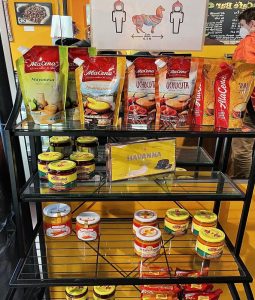From Exporting, to Migrating, to Opening an Authentic Peruvian Restaurant in Central Vancouver
by Amazona Cabanillas
I will examine a food path of Peruvian cuisine into Canada and how this path was influenced by economic policies such as those of a free trade agreement. The negotiations between Canada and Peru regarding a proposed free trade agreement, which started in August of 2002, enhanced the mobilization of people and the exportation of Peruvian goods into Canada. I will be discussing a migrant foodway that began with the exportation of Peruvian goods overseas, and how these exportations lead to a migration food path. Using as an example, a family from Peru who opened their own authentic Peruvian restaurant in Vancouver, Canada based on preparing traditional dishes with their own imported goods from back home, apart from using the locally grown produce from Vancouver.
As discussed in the book Migrant Marketplaces, economic flows such as free trade agreements can influence migration from one country to another on a large scale. Individuals are more inclined to mobilize based of off economic interests or necessities, and therefore, free trade agreements can shape waves of immigration. The author sums this up by stating that, “The tariff is always the order of the day” (Elizabeth Zanonis 2018).
One could consider that Zanoni’s findings demonstrate the relationship between free trade agreements and how they may influence the migration of different groups of people. Back in August 2002, the government of Canada announced negotiations for a proposed FTA with the Andean community and in May 2008 “The Canada-Peru Free Trade Agreement” was signed (Global affairs Canada 2016). In a publication of the Canadian government, this FTA was titled as a “Trade Agreement with Peru that Opens Doors to Latin America”, and it declared that Canada would immediately eliminate its tariffs on almost all Peruvian imports, and that the rest would be eliminated over a three to seven-year period (Foreign Affairs and International Trade Canada 2009).
Regarding migration, the Canadian census showed that from 1996 to 2016 the number of Latin American immigrants increased from 176,970 (0.5% of the population) to447,325 (1.5% of the population) respectively. And the increase in the Peruvian migrant population, which in 2016, was registered in the census as 29,620 (7% of the Latin American population in Canada). These statistics support the theory that migrants immigrated, at least in part, based on beneficial economic policies being developed in Canada.
Zanoni’s linkage between migration and how it was shaped by economic policies is consistent with the data collected on the increase of Latin American migrants during the period before, during and after the signing of “The Canada-Peru Free Trade Agreement”. The statistics demonstrate this change over time and Vancouver is currently the city with the third largest Latin American population in Canada. This data verifies that there was a gradual migration flow that was enhanced by an economic agreement. This also reflects how migrants create foodways and food communities abroad because emigrants take with them their lifestyles and their tastes, and they continue to consume products from their homeland, which sustains an active exportation of our market (Elizabeth Zanonis 2018). This account relates to the culinary journey of the owner and founder of “Silvestre Deli & Bistro”.
In 2002, Eduardo Loas, alongside his wife and three children, migrated to Canada and after being established in Vancouver, his family decided to open a traditional and authentic restaurant in 2012 called ‘Silvestre Deli & Bistro” located in central Vancouver “Gastown”. Before deciding to migrate to Canada, while still residing in Peru, Eduardo already owned a company that exported Peruvian food products for six years. The company offered everything from condiments to spices like: red hot pepper, yellow chili pepper, cumin and a diversity of ground vegetables, herbs and pasteurized fruits like “Lucuma” for making ice cream during the summer. Before founding his own restaurant “Silvestre Deli & Bistro”, Eduardo was the main distributor and supplier for many Latin American restaurants and shops in Vancouver.
Considering that Eduardo’s export company was the main supplier of Peruvians food products for other shops and restaurants in Vancouver, he found these exports to be a great opportunity for opening his own authentic and traditional Peruvian restaurant. For him, providing true authentic meals gives him a sense of pride in offering his new community a piece of his culture, his roots, his heritage. In Eduardo’s own words he described it as “the idea of opening a Peruvian restaurant occurred to me because I already had the advantage of accessing all the authentic condiments and ingredients through my own company needed for making traditional Peruvian cuisine. And making the flavor as authentic as it can be because, you know that Peruvian food without authentic ingredients just doesn’t taste good” (Eduardo Laos 2022). I can attest to the importance of using original ingredients and how much the flavor is altered by one substitute for the real actual Peruvian spice. To me, authentic Peruvian food means when that exact smell and flavor takes you right back to reliving a memory of being Peru. You can feel the country through its food and when it is prepared with the love of tradition, as is the case with Eduardo’s kitchen, it is the sensation of being there for a moment. Authenticity in Peruvian cuisine relies on specific spices, such as yellow and red-hot chili peppers and other essential bold flavors like cumin, to create a combination of rich flavors for everyone’s palate to enjoy the mélange of traditional dishes. Meaning that authenticity for Peruvians is based on history, tradition and being able to provide the experience that Peruvian diners are privileged enough to have served daily in their homes.
To this day, and as displayed in Silvestre Deli & Bistro, Eduardo continues to sell products imported from Peru. Because customers not only come in to order a scrumptious Lomo Saltado, or a delectable Causa Rellena, but Latin American migrants also come to purchase traditional condiments and spices from Peru. The food path has reached its delicious destination.

(Photo taken by the author)
In conclusion, Elizabeth Zanoni’s theory on the global connection between trade and migration, and how this may fluctuate depending on economic polices such as free trade agreements, outlines a foodway from Latin American immigration into Canada. As depicted in the data collected from the census, and the negotiations from when the free trade agreement between Peru and Canada were conducted in 2002, there is a clear foodway shown relating to Latin American immigration into Canada. That was shaped by trade. Corresponding to this theory, we have as an example, Eduardo and his family, who immigrated to Canada and brought with them a piece of Peru’s cuisine by opening an authentic and traditional restaurant alongside the sale of authentic Peruvian goods.
Bibliography
Eduardo, Laos. Interview with Amazona Cabanillas. Silvestre Deli & Bistro, Vancouver. February 8, 2022.
Government of Canada. “Canada-Peru Free Trade Agreement.” Global Affairs Canada, December 13, 2016.
Government of Canada. “Trade Agreement with Peru Opens Doors to Latin America.” Global Affairs Canada, No. 167, June 18, 2009.
“Latin American Canadians.” Wikipedia, the free encyclopedia, February 7, 2022.
Zanoni, Elizabeth. Migrant Marketplaces: Food and Italians in North and South America. University of Illinois Press, 2018.
